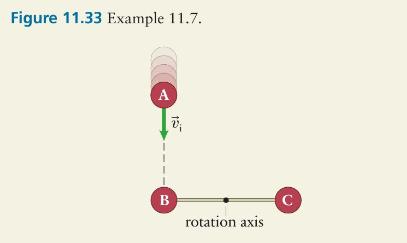(a) Follow the line of reasoning used in working from Eq. 11.28 to Eq. 11.31 to verify...
Question:
(a) Follow the line of reasoning used in working from Eq. 11.28 to Eq. 11.31 to verify that the rotational inertia of the dumbbell in Example 11.7 is indeed \(\frac{1}{2} m \ell^{2}\).
(b) Does the momentum of the system remain constant in the collision of Figure 11.33?
Data from Example 11.7
In Figure 11.33, two identical pucks B and C, each of inertia \(m\), are connected by a rod of negligible inertia and length \(\ell\) that is free to rotate about a fixed axis through its center. A third identical puck A, initially moving at speed \(v_{\text {i }}\), strikes the combination as shown. After the elastic collision, what are the rotational velocity of the dumbbell and the velocity of puck A?

Equations

![]()

Fantastic news! We've Found the answer you've been seeking!
Step by Step Answer:
Related Book For 

Question Posted:





